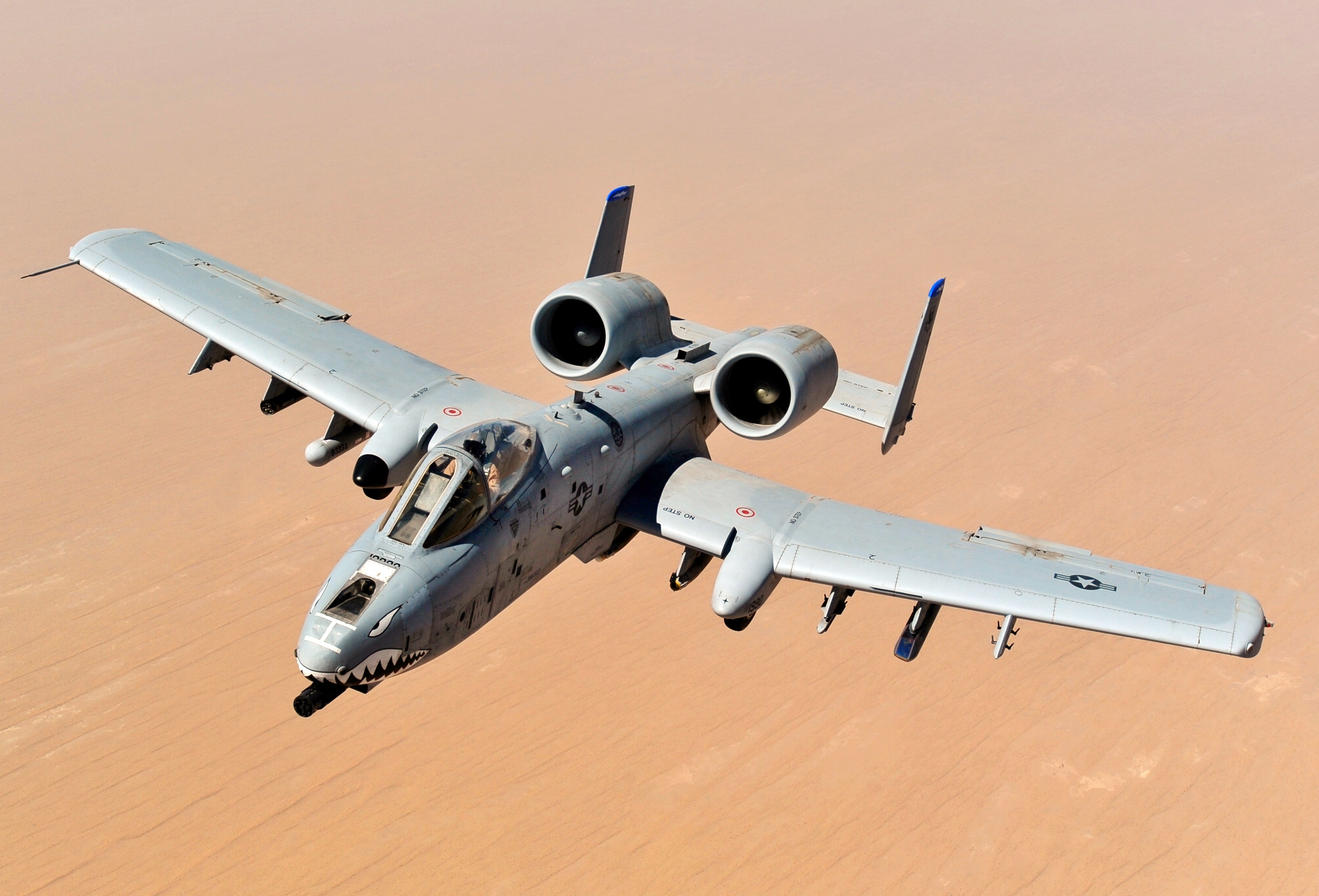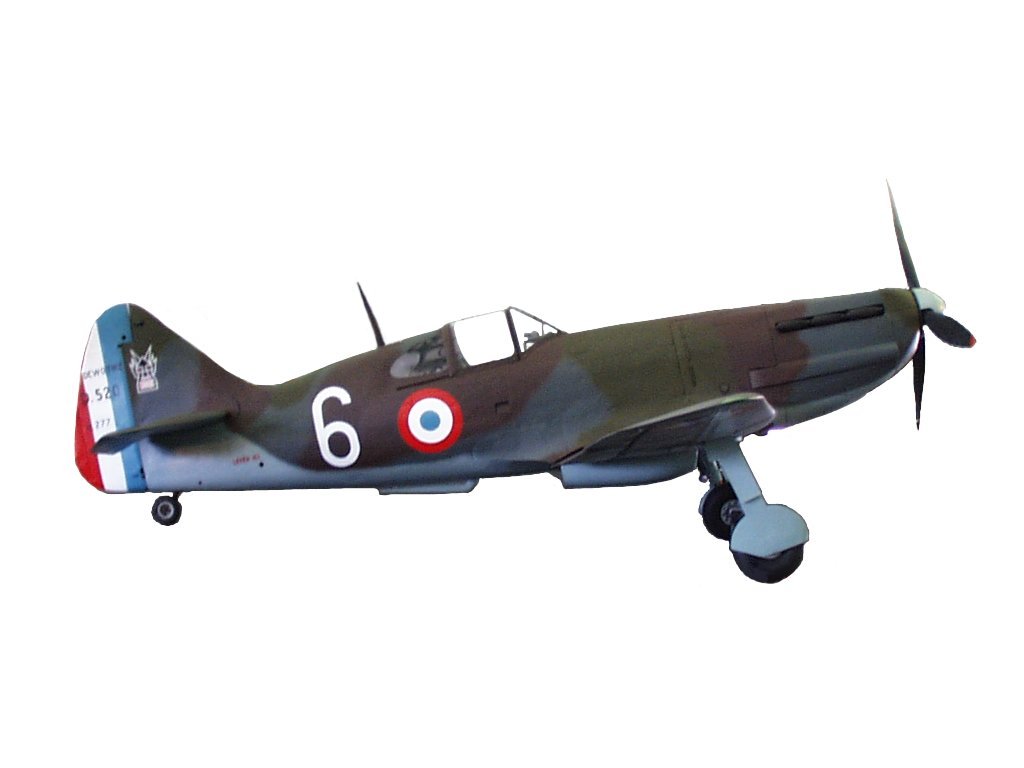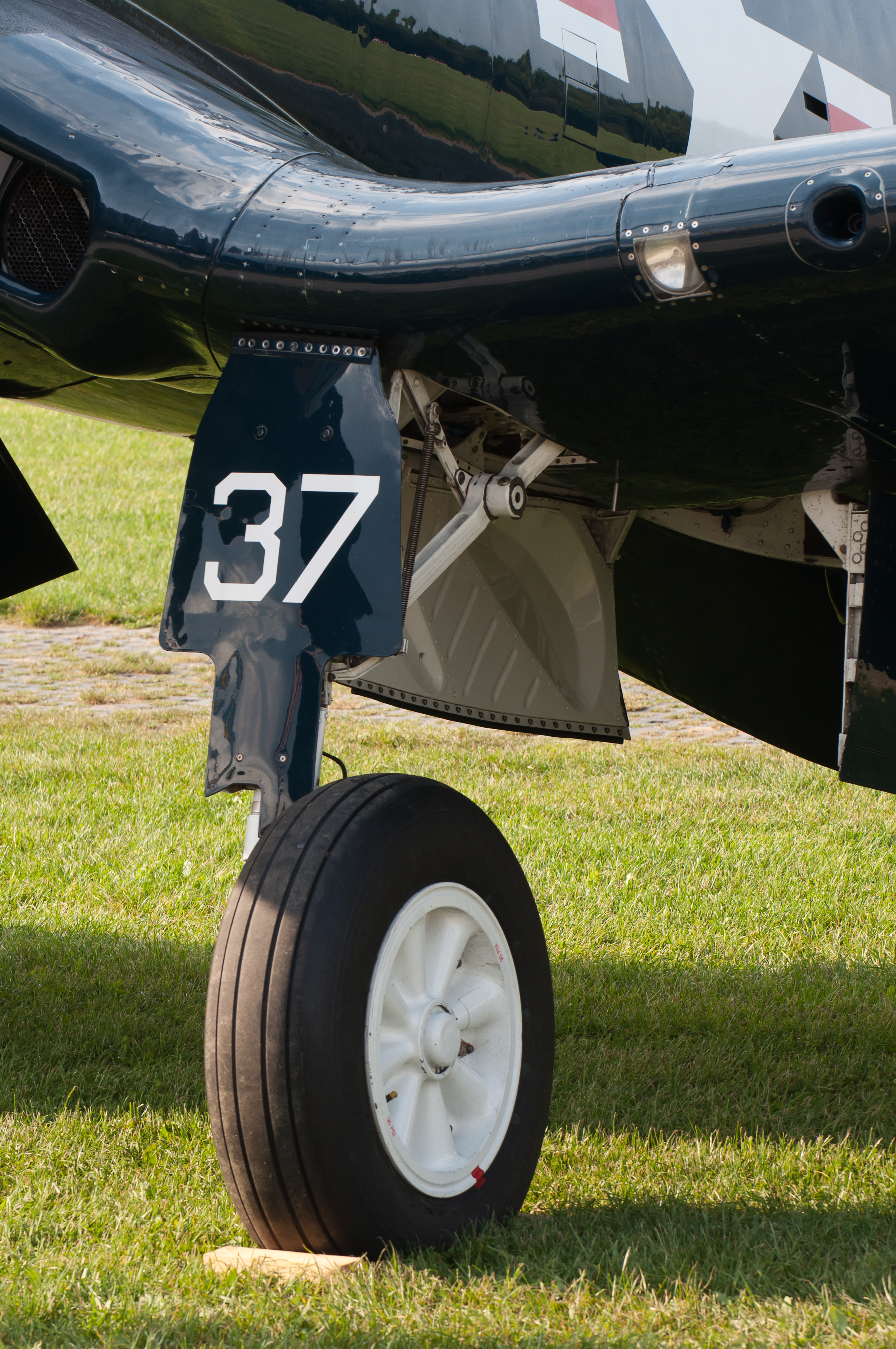|
P-47
The Republic P-47 Thunderbolt is a World War II-era fighter aircraft produced by the American company Republic Aviation from 1941 through 1945. It was a successful high-altitude fighter and it also served as the foremost American fighter-bomber in the Close air support, ground-attack role. Its primary armament was eight M2 Browning, .50-caliber machine guns, and it could carry 5-inch rockets or a bomb load of . When fully loaded, the P-47 weighed up to 8 tons, making it one of the heaviest fighters of the war. The Thunderbolt was effective as a short-to medium-range escort fighter in altitude, high-altitude aerial warfare, air-to-air combat and ground-attack aircraft, ground attack in both the European Theater of World War II, European and Pacific War, Pacific theaters. The P-47 was designed around the powerful Pratt & Whitney R-2800 Double Wasp 18-cylinder radial engine, which also powered two United States Navy, U.S. Navy/U.S. Marine Corps fighters, the Grumman F6F Hellcat and ... [...More Info...] [...Related Items...] OR: [Wikipedia] [Google] [Baidu] |
Republic Aviation
The Republic Aviation Corporation was an American aircraft manufacturer based in Farmingdale, New York, on Long Island, New York, Long Island. Originally known as the Seversky Aircraft Company, the company was responsible for the design and production of many important military aircraft, including its most famous products: World War II's Republic P-47 Thunderbolt, P-47 Thunderbolt fighter, the Republic F-84 Thunderjet, F-84 Thunderjet and Republic F-105 Thunderchief, F-105 Thunderchief jet fighters, as well as the Fairchild Republic A-10 Thunderbolt II, A-10 Thunderbolt II close-support aircraft. History Seversky Aircraft The Seversky Aircraft Company was founded in 1931 by Alexander de Seversky, a Russians, Russian expatriate and veteran World War I Aviator, pilot who had lost a leg in the war. In the beginning, many of Seversky Aircraft's designers were Russian and Georgians, Georgian engineers, including Michael Gregor (aircraft engineer), Michael Gregor and Alexander Kartveli, ... [...More Info...] [...Related Items...] OR: [Wikipedia] [Google] [Baidu] |
Pratt & Whitney R-2800 Double Wasp
The Pratt & Whitney R-2800 Double Wasp is an American twin-row, 18-cylinder, air-cooled radial aircraft engine with a displacement of , and is part of the long-lived Wasp family of engines. The R-2800 saw widespread use in many important American aircraft during and after World War II. During the war years, Pratt & Whitney continued to develop new ideas to upgrade the engine, including water injection for takeoff in cargo and passenger planes and to give emergency power in combat. Design and development First run in 1937, near the time that the larger competing 18-cylinder Wright Duplex-Cyclone's development had been started in May of that year, the displacement R-2800 was first-flown by 1940, one year before the Duplex-Cyclone. The Double Wasp was more powerful than the world's only other modern 18-cylinder engine, the Gnome-Rhône 18L of . The Double Wasp was much smaller in displacement than either of the other 18-cylinder designs, and heat dissipation was a greate ... [...More Info...] [...Related Items...] OR: [Wikipedia] [Google] [Baidu] |
Republic XP-72
The Republic XP-72 was an American prototype fighter-interceptor developed by Republic Aircraft as a progression of the P-47 Thunderbolt design. The XP-72 was designed around the Pratt & Whitney R-4360 Wasp Major 28-cylinder air-cooled radial engine with a supercharger mounted behind the pilot and driven by an extension shaft from the engine. The armament consisted of six .50 caliber (12.7 mm) wing-mounted Browning AN/M2 machine guns and underwing racks for two 1,000 lb bombs; Alternative armament packages included two 37 mm M4 autocannons with four .50 caliber AN/M2s, or four M4 autocannons. Design and development The XP-72 development paralleled that of another Republic design, the XP-69 that was to be powered by an experimental 42-cylinder Wright R-2160 liquid-cooled inline radial engine mounted in the nose of the aircraft and driving contra-rotating propellers. The XP-69 was intended for high altitude operations and featured a pressurized cockpit and armam ... [...More Info...] [...Related Items...] OR: [Wikipedia] [Google] [Baidu] |
Fighter-bomber
A fighter-bomber is a fighter aircraft that has been modified, or used primarily, as a light bomber or attack aircraft. It differs from bomber and attack aircraft primarily in its origins, as a fighter that has been adapted into other roles, whereas bombers and attack aircraft are developed specifically for bombing and attack roles. Although still used, the term fighter-bomber has less significance since the introduction of rockets and guided missiles into aerial warfare. Modern aircraft with similar duties are now typically called multirole combat aircraft or strike fighters. Development Prior to World War II, general limitations in available engine and aeronautical technology required that each proposed military aircraft have its design tailored to a specific prescribed role. Reciprocating engine, Engine power grew dramatically during the early period of the war, roughly doubling between 1939 and 1943. The Bristol Blenheim, a typical light bomber A light bomber is a r ... [...More Info...] [...Related Items...] OR: [Wikipedia] [Google] [Baidu] |
Fighter-bomber
A fighter-bomber is a fighter aircraft that has been modified, or used primarily, as a light bomber or attack aircraft. It differs from bomber and attack aircraft primarily in its origins, as a fighter that has been adapted into other roles, whereas bombers and attack aircraft are developed specifically for bombing and attack roles. Although still used, the term fighter-bomber has less significance since the introduction of rockets and guided missiles into aerial warfare. Modern aircraft with similar duties are now typically called multirole combat aircraft or strike fighters. Development Prior to World War II, general limitations in available engine and aeronautical technology required that each proposed military aircraft have its design tailored to a specific prescribed role. Reciprocating engine, Engine power grew dramatically during the early period of the war, roughly doubling between 1939 and 1943. The Bristol Blenheim, a typical light bomber A light bomber is a r ... [...More Info...] [...Related Items...] OR: [Wikipedia] [Google] [Baidu] |
Mexican Expeditionary Air Force
The Mexican Expeditionary Air Force ( es, Fuerza Aérea Expedicionaria Mexicana, FAEM) was a military aviation unit which represented Mexico on the Allied side during World War II. It is notable as the only Mexican military unit ever to fight outside Mexico itself. History Mexico declared war on the Axis Powers in support of the Allies on May 22, 1942, following losses of oil ships in the Gulf. The ''201 Squadron'' name—also known as ''Aztec Eagles''—applied to all pilots, mechanics, armorers and other personnel who were trained in the United States from July 1944 onward to take part in the conflict. The unit was previously known as the ''Grupo de Perfeccionamiento de Aeronáutica'' ("Aeronautical Training Group"). On 29 December 1944, Mexico's Senate authorized these troops to be sent into combat [...More Info...] [...Related Items...] OR: [Wikipedia] [Google] [Baidu] |
Ground-attack Aircraft
An attack aircraft, strike aircraft, or attack bomber is a tactical military aircraft that has a primary role of carrying out airstrikes with greater precision than bombers, and is prepared to encounter strong low-level air defenses while pressing the attack.Mortensen 1987, pp. 24–25. This class of aircraft is designed mostly for close air support and naval air-to-surface missions, overlapping the tactical bomber mission. Designs dedicated to non-naval roles are often known as ground-attack aircraft.Gunston 2009, p. 73. Fighter aircraft often carry out the attack role, although they would not be considered attack aircraft ''per se'', although fighter-bomber conversions of those same aircraft would be considered part of the class. Strike fighters, which have effectively replaced the fighter-bomber and light bomber concepts, also differ little from the broad concept of an attack aircraft. The dedicated attack aircraft as a separate class existed primarily during and after Worl ... [...More Info...] [...Related Items...] OR: [Wikipedia] [Google] [Baidu] |
M2 Browning
The M2 machine gun or Browning .50 caliber machine gun (informally, "Ma Deuce") is a heavy machine gun that was designed towards the end of World War I by John Browning. Its design is similar to Browning's earlier M1919 Browning machine gun, which was chambered for the .30-06 cartridge. The M2 uses Browning's larger and more powerful .50 BMG (12.7 mm) cartridge. The design has had many designations; the official U.S. military designation for the current infantry type is Browning Machine Gun, Cal. .50, M2, HB, Flexible. It is effective against infantry, unarmored or lightly armored vehicles and boats, light fortifications, and low-flying aircraft. The gun has been used extensively as a vehicle weapon and for aircraft armament by the United States since the 1930s. It was heavily used during World War II, the Korean War, the Vietnam War, the Falklands War, the Soviet–Afghan War, the Gulf War, the Iraq War, and the War in Afghanistan. It is the primary heavy machine gun of NATO ... [...More Info...] [...Related Items...] OR: [Wikipedia] [Google] [Baidu] |
United States Army Air Forces
The United States Army Air Forces (USAAF or AAF) was the major land-based aerial warfare service component of the United States Army and ''de facto'' aerial warfare service branch of the United States during and immediately after World War II (1941–1945). It was created on 20 June 1941 as successor to the previous United States Army Air Corps and is the direct predecessor of the United States Air Force, today one of the six United States Armed Forces, armed forces of the United States. The AAF was a component of the United States Army, which on 2 March 1942 was divided functionally by executive order into three autonomous forces: the Army Ground Forces, the United States Army Services of Supply (which in 1943 became the Army Service Forces), and the Army Air Forces. Each of these forces had a commanding general who reported directly to the Chief of Staff of the United States Army, Army Chief of Staff. The AAF administered all parts of military aviation formerly distributed am ... [...More Info...] [...Related Items...] OR: [Wikipedia] [Google] [Baidu] |
Brazilian Expeditionary Force
The Brazilian Expeditionary Force ( pt, Força Expedicionária Brasileira, FEB), nicknamed Cobras Fumantes (literally "the Smoking Snakes"), was a military division of the Brazilian Army and Air Force that fought with Allied forces in the Mediterranean Theatre of World War II. It numbered around 51,600 men, including a full infantry division, liaison flight, and fighter squadron.Ibidem Maximiano, Bonalume, Ricardo N. & Bujeiro, 2011. Placed under United States command, Brazilian troops fought primarily in the liberation of Italy from September 1944 to May 1945, while the Brazilian Navy and Air Force participated in the Battle of the Atlantic from mid-1942 until the end of the war. The FEB operated mostly at the platoon level, seeing heavy combat at the arduous Gothic Line and during the 1945 final offensive. By the end of the war, it took 20,573 Axis prisoners, including two generals and close to 900 officers. The division lost 948 men killed in action across all three ... [...More Info...] [...Related Items...] OR: [Wikipedia] [Google] [Baidu] |
Free French Air Forces
The Free French Air Forces (french: Forces Aériennes Françaises Libres, FAFL) were the air arm of the Free French Forces in the Second World War, created by Charles de Gaulle in 1940. The designation ceased to exist in 1943 when the Free French Forces merged with General Giraud's forces. The name was still in common use however, until the liberation of France in 1944, when they became the French Air Army. Martial Henri Valin commanded them from 1941 to 1944, then stayed on to command the Air Army. French North Africa (1940–1943) On 17 June 1940, five days before the signing of the Franco-German Armistice, the first exodus of 10 airmen took flight from Bordeaux-Mérignac Airport to England. Others rallied to General Charles de Gaulle from France and French North Africa between June 1940 and November 1942. A contingent of volunteers from South American countries such as Uruguay, Argentina and Chile was also created, as Free French officials recruited there personally. Fro ... [...More Info...] [...Related Items...] OR: [Wikipedia] [Google] [Baidu] |
Vought F4U Corsair
The Vought F4U Corsair is an American fighter aircraft which saw service primarily in World War II and the Korean War. Designed and initially manufactured by Chance Vought, the Corsair was soon in great demand; additional production contracts were given to Goodyear, whose Corsairs were designated FG, and Brewster, designated F3A. The Corsair was designed and operated as a carrier-based aircraft, and entered service in large numbers with the U.S. Navy in late 1944 and early 1945. It quickly became one of the most capable carrier-based fighter-bombers of World War II. Some Japanese pilots regarded it as the most formidable American fighter of World War II and its naval aviators achieved an 11:1 kill ratio. Early problems with carrier landings and logistics led to it being eclipsed as the dominant carrier-based fighter by the Grumman F6F Hellcat, powered by the same Double Wasp engine first flown on the Corsair's initial prototype in 1940. Instead, the Corsair's early deployme ... [...More Info...] [...Related Items...] OR: [Wikipedia] [Google] [Baidu] |

.jpg)






